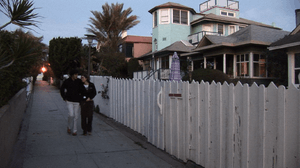Pedestrian village
A pedestrian village is a compact, pedestrian-oriented neighborhood or town, with a mixed-use village center, that follows the tenets of New Pedestrianism.[1][2] Shared-use lanes for pedestrians and those using bicycles, Segways, wheelchairs, and other small rolling conveyances that do not use internal combustion engines. Generally, these lanes are in front of the houses and businesses, and streets for motor vehicles are always at the rear. Some pedestrian villages might be nearly car-free with cars either hidden below the buildings or on the periphery of the village. Venice, Italy is essentially a pedestrian village with canals.

The canal district in Venice, California, on the other hand, combines the front lane/rear street approach with canals and walkways, or just walkways.[3][1][4]
See also
- Michael E. Arth
- New Urbanism
- New Urban Cowboy: Toward a New Pedestrianism
- Principles of Intelligent Urbanism
References
- 1 2 New Pedestrianism information
- ↑ New Urbanism and New Pedestrianism in the 21st Century
- ↑ Michael E. Arth, The Labors of Hercules: Modern Solutions to 12 Herculean Problems. 2007 Online edition. Labor IX: Urbanism
- ↑ Michael E. Arth, "Pedestrian Villages are the Antidote to Sprawl" The DeLand-Deltona Beacon, May 29, 2003. Page 1D.
External links
- Pedestrian Villages website
- Philosophy behind New Pedestrianism
- World Carfree Network
- Village Homes, Davis, California
- New Urbanism and New Pedestrianism in the 21st Century
- The New Pedestrianism: A Practical Solution, Carfree Times, Feb. 08.l
- Interview with City Architect and Reconstructor Michael E. Arth